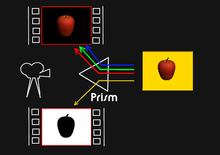Sodium vapor process
This article needs additional citations for verification. (September 2008) |

The sodium vapor process (occasionally referred to as yellowscreen) is a
Description
The process is not very complicated in principle. An actor is filmed performing in front of a white screen that is lit with powerful sodium vapor lights. This light has a narrow color spectrum, that falls neatly into a chromatic notch between the various color sensitivity layers of color film. In this way the yellow color does not register on the red, green, or blue layers.[5] This allows the complete range of colors to be used, not only in costumes, but also in makeup and props. A camera with a beam-splitter prism is used to expose two separate film elements. The main element is the regular color negative film insensitive to sodium light and the other a fine-grain black-and-white film that is extremely sensitive to the specific wavelength produced by the sodium vapor.[5]
This second film element is used to create a
History
Disney made one sodium vapor camera. The camera was a retired
At the time of its use, the sodium process yielded cleaner results than did bluescreen, which was subject to noticeable color spill (a blue tint around the edges of the matte). The increased accuracy allowed for the compositing of materials with finer detail, such as hair or Mary Poppins' veiled hat. It was also useful that the "sodium yellow" light (and its removal via the matte) had a negligible effect on human skin tones.[2] As the bluescreen process improved, the sodium vapor process was abandoned; its screen and lamps monopolizing huge studios and incurring a higher cost.[citation needed] It was also reported that there were only three of the required prisms produced.[6]
The first use of the process was in the J. Arthur Rank Organisation's Plain Sailing in 1956.
The process was used in the 1970s for scenes in
Modern recreation
On April 7th, 2024, production studio Corridor Digital published a video showcasing a modern implementation of the sodium vapor process using a custom filter setup developed by Paul Debevec.[6]
This setup had the following steps:
1) Use Low Pressure Sodium lights outputting light at a spectrum of 589 nanometers onto a white backdrop screen.
2) Illuminate the subject in front of the screen using LED lighting, making sure that none of the 589 nm light spills onto the subject.
3) Take a normal beam splitter, and put a casing around it where two sides have light filters: One Notch-Reject filter, one Bandpass filter. Using two cameras, point one at each filter.
4) This will film a foreground and a matte. When editing, start with a background image. Subtract the matte. Then edit the foreground image to remove everything that isn't part of the matte. Then add the edited foreground to the edited background on top of the subtracted area. [1]
Further reading
- US3095304A, Petro, Vlahos, "Composite photography utilizing sodium vapor illumination", issued 1963-06-25
- This Invention Made Disney MILLIONS, but Then They LOST It! (video). Corridor Crew. 8 April 2024. Archived from the original on 9 April 2024.
References
- ^ Patent US3133814A https://patents.google.com/patent/US3133814?oq=WADSWORTH+E.+POHL
- ^ a b c d Brosnan, John (1976). Movie Magic. New American Library. p. 111.
- ^ Smith, Alvy Ray (August 15, 1995). "Alpha and the History of Digital Compositing" (PDF). Retrieved January 8, 2012.
- ^ "Academy Awards Database". Archived from the original on July 11, 2012. Retrieved January 9, 2012.
- ^ ISBN 978-1-57820-283-6.
- ^ a b Northrup, Ryan (2024-04-10). "VFX Artists Recreate Groundbreaking Disney Special Effect Lost For 58 Years". ScreenRant. Retrieved 2024-04-12.
- ^ Walt Disney's “Donald and The Wheel” (1961) | Cartoon Research
- ^ Cook, Peter (23 August 2011). "Matte Shot – a tribute to Golden Era special fx". Retrieved January 8, 2012.
